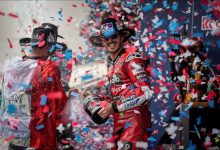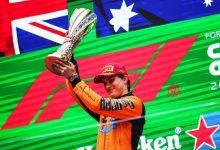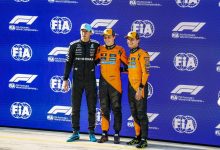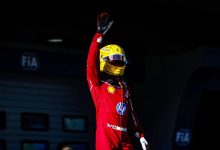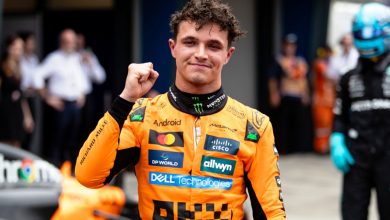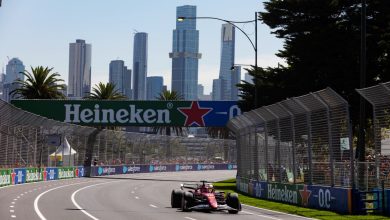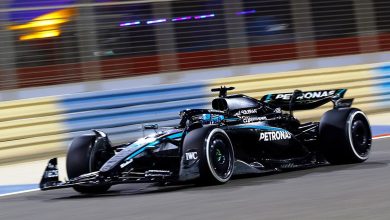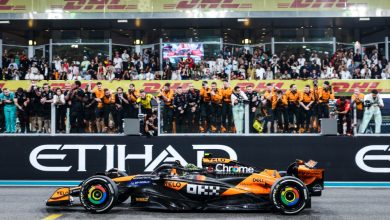Drivers are always under pressure and Hamilton is coping well, says Toto Wolff

TEAM REPRESENTATIVES – Guenther STEINER (Haas), Toto WOLFF (Mercedes), Mario ISOLA (Pirelli)
PRESS CONFERENCE
Q: Can we start with our first impressions of the Istanbul Park circuit. We’ve just had the first practice session, it looked pretty slippy out there – so what conclusions can we draw?
Guenther STEINER: I would agree with you: it was very slippy but I think the track wasn’t used for a while and there was some damp patches and it was pretty cold with the Hard tyres, so, end of the session, seems to be getting a little better when you can get some temperature in the tyres – but I think we wait for FP2. Otherwise, it’s a great place as a circuit here, it’s in very good shape, it’s just like we need to get a little bit more grip and then it will be alright.
Q: Toto?
Toto WOLFF: I think we haven’t been here for a long time and the circuit put a lot of effort into resurfacing and that is good. The consequences, obviously there is a lot of bitumen coming out and that makes it very slippery. As Guenther said, I think we just need to run and run and run and eventually the grip levels are going to increase – maybe not to the levels we know – but we need a little bit more rally skills in order to go fast tomorrow. It’s different to what we had.
Q: Mario, from Pirelli’s point of view?
Mario ISOLA: Toto is right: we have a level of grip that is lower than expected. When we selected the tyres, we didn’t know about this idea of the circuit resurface, all the track, so the characteristics of the new tarmac are different from the old one. That means that we decided for the three hardest compounds we have in our range. It’s a bit challenging for drivers but they’re all the same tyres and at the end they have to work with what they have. I believe it is quite difficult if it is going to rain because of the bitumen and the fact that you have some oil that is coming on the surface when it is raining, so we have to pay attention if, in one of the next days, if it will be wet. About the rest, probably the level of grip will increase. We don’t have support events here so obviously the level of rubber we are able to put down on track is less than usual and this is another element they have to consider in strategies and track evolution.
Q: Mario, knowing what you know now, might you have brought softer compounds to this race?
MI: Maybe yes – but we have data that are very, very old. Ten years ago we had a completely different situation, different tyres, different compounds and different cars, so we are looking at this circuit as a new track. We made our simulation considering this circuit as a new track and yes, obviously we had a look at the data from 2011 but I believe they are not very relevant, so maybe yes. We know that Turn 8 is quite severe on the tyre. The rest of the circuit is not so heavy, so severe on tyres. Knowing the characteristics of the tarmac in advance, yes, maybe it was good to go one step softer.
Q: Mario, staying with you and throwing it two weeks back if I may, what update can you give us regarding the failure on Max Verstappen’s car at Imola?
MI: We made an investigation on the tyre and the part of the tyre that we have been able to collect. We found some cuts on the tread and the sidewall, both in inside and outside. We believe that the reason of the failure was damage on the centre of the tread that caused the damage on both the belts and the carcass plies. So the belts started to detach following this damage and at a certain point, when the carcass was not able to keep the load, we had the deflation that everybody saw on television. We shared the analysis with the FIA and the team and this is the evidence that we have. Obviously it is difficult to analyse a tyre that is in pieces but we sent immediately the tyre back from Imola to our laboratories in Milan and we did an investigation as a priority.
Q: Thank you. And going a week earlier, if I may, to Portimão, the Portuguese Grand Prix, what conclusions did you draw from the tyre test that you carried out there during FP2, and what changes to the tyres can we expect for 2021?
MI: We have decided to homologate a new front and a new rear construction. The new front is the one with the biggest difference compared to this year, with the different profile, a different construction. We carry over the compounds to next year. Obviously it is impossible in one test to redesign all the range of compounds but we have this new specification. We are going to supply the new specification to all the teams in Bahrain and probably Abu Dhabi. We are discussing this in these days, to give all the teams the possibility to test the final – the homologated – version of this specification. Because in Portimão we supplied different prototypes to different teams, not the same to everybody, so not all the teams have been able to test what we have decided to homologate, so that is the plan for the next events. Obviously, I am talking about the first race in Bahrain on a layout that is well-known by the teams and the race in Abu Dhabi, again on a layout that is very well known.
Q: Toto, Lewis has his first match-point this weekend. Have you seen any sign of nerves from him so far?
TW: No. I think the drivers are always under pressure to perform and he’s been coping well with that in the past and no difference in behaviour pattern than the previous races.
Q: Now, there’s so much talk and speculation about his future. If he wins title number seven here, does that trigger the start of the negotiations about next year?
TW: Yeah. I don’t want to drop a date here because, if I do, everybody’s going to ask at every single race – but this is what we agreed. I think it was important to make sure that we have both titles secured and then have a more relaxed approach to the discussion about the future.
Q: How relaxed can you be – because it’s only 48 days until the start of 2021. Is there any part of you that’s getting nervous or even feeling cornered in your negotiations with Lewis Hamilton?
TW: No, not at all Tom. It’s a good dependence on each other. We would like him in the car and I think he wants to drive the Mercedes – because it’s competitive. So, no, I think there is a good balance.
Q: And, from a Constructors’ point of view, obviously you won number seven last time out in Imola. In these COVID times, can you tell us how the team has celebrated. I guess it’s been different to previous successes for you?
TW: Yeah. I don’t know. For myself, I can say that this one felt very special. We are not very good in celebrating, we always look forward – but there were moments where I was very proud of what the team has achieved. That was reflected also in the various video calls we had right after the race – but we will certainly find some time and allocate some time when it’s becoming easier with Corona to celebrate that title – because it’s a special title.
Q: Guenther, a few stresses getting one of your drivers to the race track in time this weekend. How did he break the news to you – Romain Grosjean we’re talking about – that he’d missed his flight.
GS: The team-manager had told me that he’d missed his flight and he’s coming on Thursday morning, so it wasn’t a big panic anyway. It sounded more dramatic than it was. He was here on Thursday morning, I saw him about 0900-0930, so no big drama to me.
Q: In your history in Formula 1, have you ever had another driver who’s missed flights? Caused you any grief?
GS: Yes!
Q: Can you tell us any names?
GS: Kevin Magnussen! He missed his first flight. To a meeting – maybe it wasn’t to a race but to a meeting with Gene Haas. He told me: “I’m sitting in Frankfurt, I missed my connection.” Good for you, you know! He was going to California. I’m pretty used to it. I’m calm about it. He missed a flight and then immediately arranged something else and we knew that he was coming the next day, so there was no panic, you know?
Q: And while we’re talking about drivers, how close are you to announcing your line-up for 2021?
GS: I copy Toto here. I don’t want to tell you a date because then you keep on asking me. So, I learn from the best, giving answers. I don’t know when we announce it. We are getting closer. We’re getting close, put it this way.
VIDEO CONFERENCE
Q: (Dieter Rencken – Racing Lines) Question to Guenther and Toto please. On the Monday after Portimão, there were discussions on banning wind tunnels from 2030 etc., On the one side, Guenther, you don’t have one within your team, and on the other side Toto, you’ve probably got the best, if not amongst the best wind tunnel. How do you feel about this and can CFD really replace wind tunnel testing?
GS: I think everything is possible and technology gets better, as we all know. Technology is advancing in big steps, so I think we don’t need to decide now, but going in that direction I think would maybe be the right thing to do. I think it’s too early to come to a complete conclusion but, if it is like this, if everybody is the same, this is what we are going do, I will support it.
Q: Toto?
TW: Yes, I think there was broad agreement that over the long term this would happen but it’s such a massive regulatory change that also involves certain safety aspects. We must not forget that these cars are the fastest on the planet with the most downforce and we don’t want to experiment live with drivers in the car based on CFD. As for our tunnel, it’s the same generation as a few others in the paddock. We’ve worked on the tunnel over the last years as has everybody else, and people tend to say there is a silver bullet, that the tunnel is very good or the tyre analysis is very good, or the engine is very good but it’s always the combination of everything. Therefore, I think setting a target like 2030 banning wind tunnels is a path that works for everybody and is going to help us make the sport more sustainable from the financial side.
Q: (Andrew Benson – BBC) Question for Toto and Mario. I believe that Mercedes also had tyre problems in Imola with vibrations which obviously can be a precursor to a failure. I wondered if the two entities, Mercedes and Pirelli, had investigated that and discovered whether there was a significant problem. And Mario, just for you, what characteristics are you trying to achieve with this new tyre for next year?
TW: So, it started with a little vibration and we decided to pit the car also in order to not take any risks. It was something that isn’t yet understood. The tyre remained intact and was sent to Milan for analysis and we’re waiting for the results.
MI: Yes, I can confirm that we are analysing the tyre together with the team, so the findings will be shared with the team. As Toto said, there was no loss of pressure, just vibration increasing during the run. We are investigating the construction. Obviously in this case it is possible to investigate the tyre because it is available. For the second question, the target of the new construction was mainly to increase the level of integrity. What we can see from telemetry data, that we receive after each race, is that obviously the level of performance – that means the level of load – that these cars are putting on tyres, is growing every weekend and therefore we usually develop new tyres every year in order to increase the level of integrity and on the other side to limit the increase in pressure that obviously is leading to other… not issues but consequences like overheating, for example, or higher degradation. Last year it was not possible. We homologated the 2019 product also for 2020 but we had no plans to carry over the 2020 tyres also for 2021, so what we agreed with the teams was to have this possibility to test in FP2 and it is what we did with tyres that are designed not to increase the level of performance – that was not the target – but to increase the level of integrity. The prototype we selected is giving this feedback on our indoor testing and when it was tested in Portimão, the feedback was quite positive – or at least in line with the current specification – and this is what we have done.
Q: (Scott Mitchell – The Race) Toto, F1 has made it clear that hybrid engines and the combustion engine are going to be a part of F1 for the long term. At the moment the next gen engine is going to be in 2026 and there has obviously been talk about whether than can be brought forward and how it needs to be made simpler and cheaper to attract more manufacturers. Do you think moving the new engine forward from 2026 is possible and do you think sustainable fuels could be a way of doing that so by introducing a 100% sustainable fuel or by simplifying the hybrid element or something like that?
TW: Nice beard! So the discussion was very good – one of the positives. It’s interesting where the auto industry goes because everything develops in the direction of electric mobility but there is also a new look at the internal combustion engine and the combination with electric drive. I believe we should look at the costs. Developing a completely new power unit is not somewhere we should go. We know that we made that mistake in 2011 and 2012 when we made a highly sophisticated and also very efficient power unit but it got very complex. As things stand I think we need to have a combination of what we have today – an internal combustion engine and add hybrid energy and power in order to have a better ratio between sustainable energy propulsion and conventional ICE engines. I don’t think it’s about simplifying, it’s just about trying to not have escalating costs and apart from the more electric component with potentially larger or more powerful battery pack, sustainable fuels are definitely the future. In 2025 we should have a 100% sustainable fuel, whether it’s synthetic fuels or biofuels, but it should come with a big step for 2025 and not with a gradual increase over the next years because again that would make the power unit development more expensive.
Q: (Christian Menath – motorsport-magazin.com) Toto, when people talk about Lewis and his achievements many people think about just the raw talent of Lewis but he is a professional athlete and I think during the years her became a more professional athlete from year to year. Did you see this development as well and what you think was the impact of the defeat against Nico in 2016?
TW: I think what I realised over the last years is his permanent self-analysis, how to get better, he has become really good at identifying points of weakness and then tackling them, and he has progressed over the years as a racing driver in the car and as a personality outside the car. And that is something that you see very rarely with people, that they are critical enough, while not beating themselves up, in order to progress. Many others in Formula 1 and outside Formula 1, you’re not really good at identifying your own shortcomings and therefore you stagnate in your development and it’s a thinking pattern that with him simply doesn’t exist. He is constantly seeking perfection.
Q: And the impact of Nico Rosberg’s championship in 2016?
TW: I don’t think that played any role. I think that annoyed him back at the time and I think he moved. I don’t think there was a particular thing to learn in that year. Nico was strong. Lewis had some DNFs leading races and in the end it is what it is.
Q: (Ronald Fording – motorsport.com, via e-mail) Toto, you’ve talked about the years as a team principal taking its toll and probably moving into another role within Mercedes. Does the timing of that move only depend on your successor and when he or she is ready, or do you have any doubts about stopping as a team principal yourself?
TW: I believe that each of us has a certain shelf life as a team principal. It’s simply not sustainable to do a few hundred races and be the best you that started on the journey. It is a job that involves being in an airplane on 20 or so races and coming back on Monday you have an office job. I did 250 hotel nights last year and 500 hours of flying. It is certainly not something I want to do for the rest of my life. But I take enjoyment in what I do and I certainly don’t want to step away from the Mercedes team. I’m co-owner with Mercedes and this is something I am very proud of but it has become quite a large company. Our engineering arm, Applied Science, is growing strongly and I believe that I should hand over the baton as team principal to somebody that will start his journey with the same motivation and energy that I had when I started. That is a natural progression that we have done on technical level over the many years and I would be very proud seeing somebody performing better than I do and I will be watching that from a different, more senior role.
Q: Have you already identified that person.
TW: Hmmm. Maybe.
Q: (Edd Straw – The Race) For Toto. There are a couple of triple headers on next year’s calendar but when F1 had a triple-header a few years ago it wasn’t that popular and there was a desire to limit them and perhaps only use them for flyaways, but we have a European one next year. Obviously they were necessary this year but do you think it’s a necessary for triple-headers to be a fact of life in F1 or do you think there should be push to move away from them just to avoid overloading personnel etc?
TW: I think the teams are the beneficiaries of growing revenue and growing income. The teams still take a large chunk of the EBITDA and in that respect we all need to support for the business to grow. On the other side a couple of triple-headers will take a toll on the people. I think there is an Asian triple-header that will mean we are more than three weeks away from home and that is certainly not something that is great. You must not forget that the hardest working people are the ones that set up the garages and take them down and the mechanics that will have overnighters if something goes wrong [and they will] suffer, no doubt about that. You need to question how long that is sustainable and whether you implement a different system by having a second crew that can take over these toughest roles and this is something we are looking at at the moment.
Q: Guenther, could we get your thoughts on triple-headers next year?
GS: Yeah, it will take a toll on the people but I think especially in the times we are in now we need to do it but then FOM needs to look into it; if it is something we want to do for the long term or it’s just a one year off; if this many races are sustainable and if there is no saturation coming in by the spectators, if it actually is beneficial or not and on the people side of it we need to come up with plans that we don’t overwork them. We overwork them anyway, but we need to be clear that we cannot demand that all the time. That is part of our job. If it gives us more revenue we need to come up with ideas where we make it sustainable for ourselves, where we don’t need to wait until we are told to do that. It’s part of where Formula 1 is going. We will just find out in a few years if it is the right or not, if more races is the right way. We need to try it and try to find some solution where our people do not get worn out. That they can keep on working and that there are enough people wanting to do this job. I think there are enough people out there wanting to work in Formula 1 so I think we are still in a good place, so I think we just wait a little bit.
Q: (Alan Baldwin – Reuters) Going back to Lewis and seven championships. Comparisons are inevitably going to be made to the likes of Roger Federer winning grand slams, Jack Nicklaus, six Masters, multiple winners of the Tour de France. It is an individual championship. I know Formula 1 is a team sport. People say it’s the car, put anyone in the Mercedes and they will win. Do you think Lewis Hamilton, as a seven-times world champion, will get the respect and his just dues and how do you see Lewis in relation to those other champions?
TW: In any sport, and also in motor racing, there were people that stood out. In motor racing it was Fangio, it was Senna, Michael of course, Sebastian in the 2010s, and now Lewis. I don’t think you can compare them really because every time had different competitors and needed different skill sets. But certainly among them his sheer record stands out and he is on a par with Michael today, who for me personally was the greatest driver in Formula 1 and Lewis is still in his career and he can maybe achieve more in terms of the sheer record. Into the other sports, it’s the same case. There are some very, very outstanding people that have really stood out and Roger, for me, is not only an amazing tennis player but he is also a great personality. Within that generation you will have Roger and Nadal and yeah, that’s pretty much it I think. You will have the same in golf and soccer and American football, you have these outstanding guys that have just natural ability, social intelligence and hard working skills.
